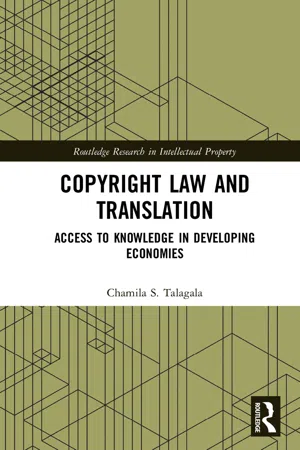
Copyright Law and Translation
Access to Knowledge in Developing Economies
- 238 pages
- English
- ePUB (mobile friendly)
- Available on iOS & Android
About This Book
Arguing that the translation of scientific and technical learning materials, and the publication of these translations in a timely and affordable manner, is crucially important in promoting access to scientific and technical knowledge in the developing world, this book examines the relationship between copyright law, translation and access to knowledge.
Taking Sri Lanka as a case study in comparison with India and Bangladesh, it identifies factors that have contributed to the unfavourable relationship between copyright law and the timely and affordable translation of scientific and technical learning materials, such as colonisation, international copyright law, the trade interests of the developing economies and a lack of expertise and general lack of awareness surrounding copyright law in the developing world.
Highlighting the need to reform international copyright law to promote the needs and interests of developing countries such as Sri Lanka, the book points to a possible way forward for developing countries to achieve this and to address the problem of striking a proper and delicate balance in their copyright laws between the protection of translation rights and the ability of people to access translations of copyright protected scientific and technical learning materials.
Frequently asked questions
Information
III The British model of copyright law and translation [1908–1979]
3.1. Introduction
3.2. British model of copyright in Sri Lanka
3.2.1. The Copyright Ordinance 1908 and translation
Table of contents
- Cover
- Half Title
- Series
- Title
- Copyright
- Dedication
- Contents
- Acknowledgements
- List of abbreviations
- Table of international treaties, conventions and other instruments
- Table of statutes and bills
- Table of cases
- I Introduction
- II Access to scientific and technical knowledge, translation and copyright in Sri Lanka
- III The British model of copyright law and translation [1908–1979]
- IV WIPO model of copyright law and translation [1979–2003]
- V TRIPS model of copyright law and translation [2003–2020]
- VI Conclusion and the way forward
- Bibliography
- Index